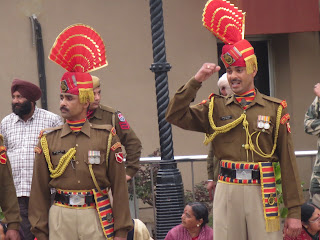U.S. Embassy
We started the day with a fantastic visit to the U.S. Embassy in New Delhi. Many thanks to David Leishman, Allan Mustard, Sheila Desai, Santosh Singh, Amit Aradhey, Thom Wright, and the other great staff who gave us a broad perspective of America's role in diplomatic relations with India's agricultural sector. They helped us understand the challenges and opportunities that exist for both Indian and American agriculture moving forward.
India is home to 30% of the world's bovine population (30% water buffalo and 70% cattle), but only 5% of the world's pasture and forage. 30% of India's cropland is irrigated (by groundwater and publicly-available surface water), and the other 70% is farmed as dryland. India's "grain belt" is located in three of the northern provinces, including the Punjab region we will visit later this week. This area is irrigated by perennial rivers that are fed by the Himalayan glaciers.
Other notable facts are that 37% of the population lives below the poverty line (but this has been improving over time, every 5th child is malnourished, and there are more cell phones than toilets in India.
Final words of wisdom from our Embassy hosts were, "diplomacy and technical assistance are a lot cheaper than war."
India Minister of Minority Affairs
Next we had the opportunity to meet with Mr. K. Rahman Khan whose Minister position is equivalent a U.S. cabinet secretary position. His role is to enforce the constitutional amendment that provides equal justice for linguistic and religious minorities. We learned that there are a reserved number of seats in Parliament for these underrepresented tribes and castes, in addition to other social support such as micro-financing and subsidized fuel.
.JPG) |
| Minister of Minority Affairs with Dr. Thomas. |
Humayun's Tomb
We visited the tomb of the Mughal Emporer Humayun, which is built in a style very similar to the Taj Mahal. The tomb was commissioned by Humayun's wife in 1562. It was the first garden-tomb built in India.
 |
| Mike Testa, Dr. Flores, and JJ Gross in front of Humayun's Tomb, Delhi. |
India Minister of Steel
We had a meeting with Mr. Verma, the Minister of Steel, whose role is to regulate the extraction, manufacturing, and exporting of steel. Besides learning about the steel industry from his great policy staff, this meeting was also an interesting cultural experience. We learned that India is the world's fourth largest exporter of steel, and that India's energy production consists of 60% coal, 20% hydroelectric, and the rest is from nuclear and gas.
Dinner with U.S. Embassy and Agriculture Industry Guests
We enjoyed a great dinner with guests from the U.S. Embassy, the India cotton industry, and the California Almond Board. We really appreciated them taking the time to visit with us and help us understand more about Indian culture, as well as the relationships between the India and U.S. agricultural sectors.
Submitted by Cade Johnson, Cameron Boswell, and Elisa Noble



















.JPG)













